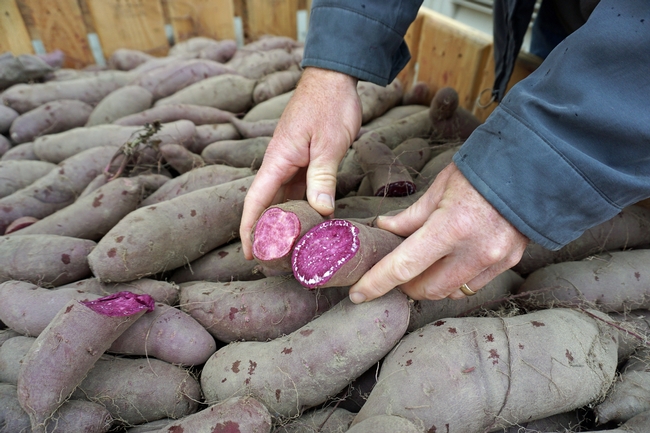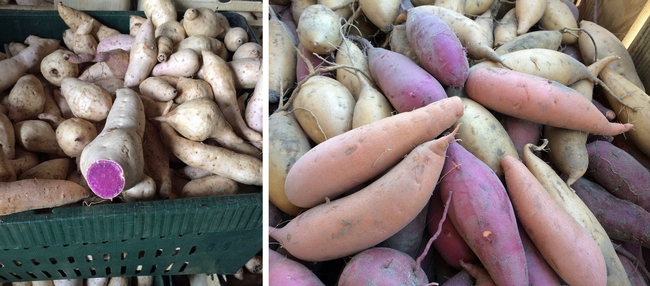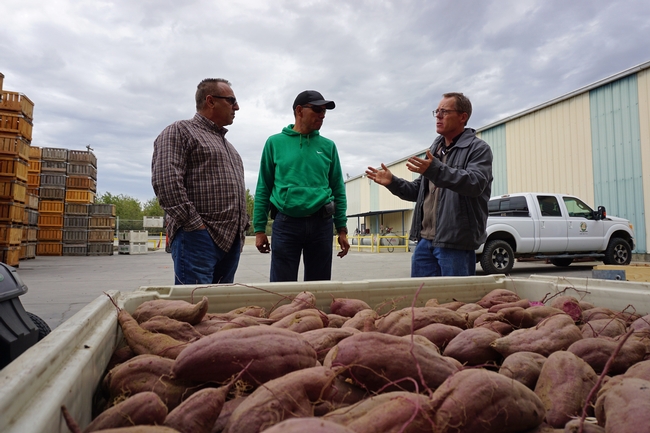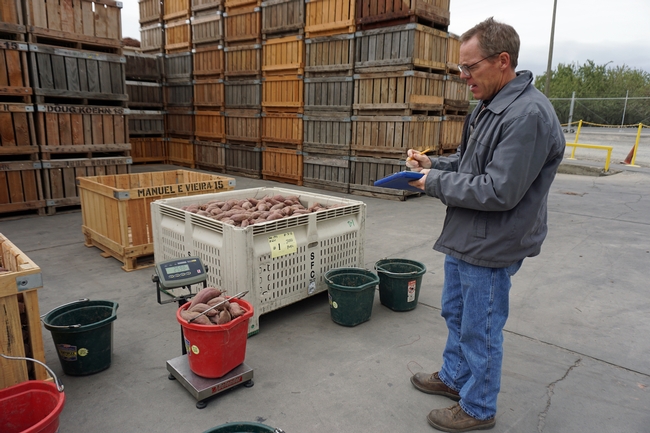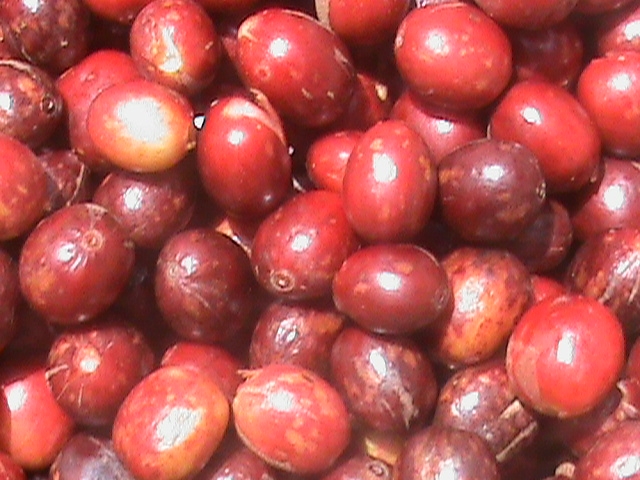Posts Tagged: potato
Vibrant purple sweet potatoes are a healthful Thanksgiving surprise
Candied sweet potatoes – dripping with butter, brown sugar and pecans – or a casserole of mashed sweet potatoes smothered with toasted marshmallows are common sides on the Thanksgiving table. These rich dishes belie the true nature of sweet potatoes, which are nutrient packed, low-glycemic root vegetables that can be a part of a healthy diet year round.
Research by UC Cooperative Extension advisor Scott Stoddard is aimed at making sweet potatoes an even more healthful and attractive food. Stoddard is working with sweet potato growers in Merced County to see if sweet potatoes with dusky purple skin and vibrant purple flesh, called purple/purples, can be grown by more farmers in California. The unusual color and health benefits command a higher price, opening a potentially profitable niche market.
“Purple flesh sweet potatoes have beta-carotene, like the more common orange varieties, plus anthocyanins,” Stoddard said. “It's like eating a handful of blueberries with your sweet potato.”
California is a significant producer of sweet potatoes. About 80 percent of the California crop – 16,000 acres – is grown in Merced County, on farms ranging from 5 acres up to several thousand acres. In 2015, the crop's value in Merced County was $195 million. About 1,000 acres are grown in Kern County and 2,000 acres in Stanislaus County. These locations have the sandy and sandy-loam soils ideal for sweet potatoes to develop their distinctive shape and smooth skin.
Sweet potatoes with purple flesh are not common, but they have been around for quite some time. They are the main type of sweet potato grown in Hawaii, for example. Several years ago, growers in Stokes County, N.C., selected a particularly beautiful and tasty cultivar, naming it the Stokes Sweet Potato and marketing nationwide with Frieda's Specialty Produce. In California, A. V. Thomas Produce in Livingston acquired an exclusive agreement with the company to grow and market Stokes purple/purple sweet potatoes.
“The number of acres of Stokes has really expanded in just a few years,” Stoddard said. "There is a lot of consumer interest in purple-fleshed sweet potatoes."
That doesn't close the door on purple/purples for California's other growers interested in the niche. Stoddard conducts field trials in cooperation with local farmers that include purple/purples. In one trial, 50 types of sweet potatoes of many different colors are being grown to determine whether they have key characteristics needed for local production. From there, he selects a limited number to grow in replicated trials, to determine their potential to produce a high yield, store well, and develop good size, shape, color and flavor. Of these, only one purple/purple made it into the replicated trial.
“In some purple/purples, the flavor can be off, or bitter,” Stoddard said. “We get rid of those right away.”
One of the cultivars in Stoddard's study, which goes by the experimental code number L-14-15-P, was bred in 2014 by Don La Bonte, a plant breeder at Louisiana State University, Baton Rouge. The potato has some good attributes, but lacks the uniform deep purple color of the Stokes variety.
“Unfortunately, it's probably not good enough to displace Stokes,” Stoddard said. “It's a good start, but we have to continue screening purple/purples to find a variety that offers disease resistance, good yield, and consistent deep purple flesh color."
Good eats
Sweet potatoes can be eaten raw or cooked. To eat raw, simply peel, cut into sticks and serve with low-fat ranch dressing or apple sauce for dipping. Grate fresh, uncooked sweet potatoes and add to burritos or tacos or sprinkle on salads for a sweet, nutritious crunch.
Cooked sweet potatoes can be eaten for breakfast, lunch or dinner, skin and all, plain or with a small pat of butter.
Microwaving is a great way to quickly prepare the vegetable. Wash potatoes and pat dry. Prick skin with a knife in 2 to 3 places. Cook on high for 5 minutes. Turn over. Then cook for another 5 minutes, more or less.
UC Cooperative Extension's sweet potato expert Scott Stoddard says he prefers his sweet potatoes baked.
“Baked is way better,” he said. “Baking gives time to convert the starch to maltose.”
Sweet potatoes are mostly starch, but have a special enzyme that breaks down starch into maltose when cooking. Slower cooking in the oven provides time for the conversion, imparting a subtly sweet caramelized flavor.
To bake, preheat the oven to 400 degrees. Line the lower oven rack with foil, then prick sweet potatoes with a fork and place directly on the middle oven rack, above the rack with foil. Bake 45 minutes for sweet potatoes 2 to 3 inches in diameter.
Sustainable food systems depend on healthy plants
Discolored leaves. Decaying roots. Dead wood. Mother Nature offers a fascinating and colorful backdrop of clues to track microscopic killers. Much like any medical mystery, experts are called in to diagnose or identify a disease from its symptoms and recommend management strategies to prevent further damage or loss of healthy plants.
In the world of crop science mysteries, plant pathology solves the crime. The usual suspects include bacteria, fungi and viruses.
Humans and animals depend on plants for their food supply and ultimately for their survival. When diseases threaten crops, a high-quality, affordable food supply is placed at risk. For growers, plant diseases can reduce crop yields. For consumers, reduced crop yields can drive higher food prices. Plant pathology research holds enormous implications for a sustainable food supply.
Florent Trouillas, who was named UC Cooperative Extension specialist in the Department of Plant Pathology at UC Davis and the Kearney Agricultural Research and Extension Center last year, explains the bottom line of most concern to growers.
"Once we identify a disease causal agent, a main question remains from growers. What growers really want to know is how to control the disease and prevent its spread to new healthy plants; they look to the University of California for solutions," Trouillas said.
A crisis in the food production system can impact other areas of society as well. In fact, history is filled with examples of how plant diseases influenced economies, environments and human societies.
Trouillas cites one of the most well-known examples in plant pathology: the Great Famine. Millions of Irish immigrants relocated to the United States in the mid-1800s after a terrible potato blight led to widespread starvation in Ireland. Experiments conducted in 1861 by Anton deBary, considered to be one of the founding fathers of plant pathology, proved the blight was caused by a fungus, which we now know is an oomycete. This plant disease had a direct impact on the Irish society with a subsequent Irish immigration wave into America.
Another historical illustration of plant pathology research occurred in the 1920s. The most common trees in the forests of the United States at the turn of the century were the majestic American chestnuts. The trees generated income for humans and the timber industry, served as a food source for people and animals, and provided habitat for wildlife. Then the trees started dying, until by the late 1920s, they had become the first tree in modern times on the brink of extinction. Plant pathologists were particularly adept at identifying plant diseases by this time and diagnosed the Cryphonectria parasitica fungus as the cause of the chestnut blight. By preventing the extinction of the pivotal species, plant pathology had a direct impact on the economy and the environment.
More recent major plant disease outbreaks in the United States involving plant pathology research have included Sudden Oak Death with devastating effects in California and Oregon forests, pitch canker killing California native pine species, and citrus canker in Florida, which has had a huge economic impact on the industry.
Veterinarians treat diseases in animals, physicians in humans. Trouillas describes the role of plant pathologists in similar terms. “We study the pathology of plant systems. Plant pathologists treat plants," he said.
Healthy plants ensure a sustainable food source and habitat for so many other organisms, including the human species.
Is there a potato in my coffee?
So pernicious is PTD that its occurrence can downgrade the value of the entire crop by a fourth or a third. Worse yet, PTD is only apparent after processing, roasting, grinding and brewing, and can occur long after the coffee has been shipped abroad.
Thought to be caused by chemicals produced by microbes that gain access to the coffee cherries by way of a stink bug called antestia, PTD has gained the attention of an international effort, called the potato taste project, that for two years has sought the cause and cure for the defect
Two undergraduate students at the University of California, Riverside, have played key roles in the potato taste project.
“Lauren Wong and Tony Truong made a key breakthrough discovery that led to our asking one of UC Riverside’s plant pathologists, James Borneman, to do a microbiome of coffee beans in Rwanda,” says Thomas Miller, a professor of entomology at UCR and one of the members of the international team working to mitigate the potential impact of the defect on Rwanda’s specialty coffee industry.
Wong and Truong focused on the microbial difference between the defective coffee beans and the beans that passed the stringent criteria that allows them to be deemed specialty coffee. Wong swiped good and bad raw coffee beans onto culture plates and found a dramatic difference: the good beans produced clean fungal colonies while the bad beans yielded mixed cultures of bacteria and fungi.
“We juxtaposed beans that had passed the stringent criteria against numerous batches of beans that had potato taste defect,” says Wong, who graduated in spring 2013 with a bachelor’s degree in biological sciences and is currently working in Miller’s lab. “When we roasted the beans, we found that all the potato taste defect microbes were killed.”
Truong examined whether the potato taste defect microbes can be manipulated to affect coffee taste.
“My experiment is a stepping stone to finding a solution for potato taste defect,” says Truong, who will graduate with a bachelor’s degree in biochemistry in 2015. “Are bacterial/fungal infections the source of the problem? Can the affected coffee beans be treated to remove the effects of potato taste defect? These are some of the questions I am exploring.”
Neither Wong nor Truong have traveled to Rwanda yet, but are in close communication with researchers there. With its high altitude and volcanic soil, Rwanda is an ideal place to grow specialty coffee. To tackle the antestia-potato taste challenge, Miller and the rest of the international team traveled to Rwanda in early 2012 to join coffee researchers at the National University of Rwanda (NUR).
Then, Miller stayed in Rwanda for two weeks that comprised meetings, workshops and numerous field trips. He has been in nearly daily email contact with Rwanda since.
“That visit helped us all get a better understanding of potato taste and its causes,” he says. “We gathered coffee bean samples for analysis in the United States and began collaborating with Rwandan scientists. We also assisted Rwanda in reaching out and making contact with people willing to help solve the potato taste defect problem.”
The culmination of the first two years of the PTD project will be a coffee summit on 1-2 April 2014 at NUR. The meeting is being organized by NUR and the Global Knowledge Initiative, a Washington DC, non-profit organization dedicated to finding solutions to problems in developing countries.
More information about PTD can be found at www.coffee.ucr.edu.
Enjoy California sweet potatoes around the clock and calendar
Sweet potatoes are perhaps most familiar in the U.S. smothered with melted marshmallows in a Thanksgiving casserole. But baked, boiled or raw, they can be a healthful part of California cuisine any time of year.
California is a significant producer of sweet potatoes. About 90 percent of the California crop – 18,000 acres – is grown in Merced County, on farms ranging from 5 acres up to several thousand acres. In 2011, the crop’s value statewide was $125 million.
However, you probably won’t find sweet potato farmers at your local farmers market.
“Even smaller growers tend to work with a packing shed and have their crops combined with others and marketed,” said Scott Stoddard, UC Cooperative Extension advisor in Merced County.
A few years ago, when sweet potato fries began showing up at high-end restaurants and fast food chains across the country, the U.S. and the California sweet potato industries overestimated the future growth in sweet potato consumption, Stoddard said. In addition, improvements in growing practices boosted yield per acre, leaving the country with something of a sweet potato glut. Currently, acreage is inching down again as growers balance supply with demand.
Most sweet potato breeding programs are conducted in the South, such as Louisiana and North Carolina, but the characteristics sought in that part of the country are different than California. Stoddard is conducting specialized variety trials in California to select varieties with red, purple or garnet skin.
“In California, we are going for a red-skinned sweet potato,” Stoddard said. “Especially, a red-skinned variety that stores well.”
Some people incorrectly believe that sweet potatoes with moist orange flesh are yams. True yams can be found elsewhere in the world, but in the U.S., a sweet potato is a sweet potato, whether the flesh is orange, yellow or white and whether the skin is tan, dusty pink or garnet red.
Sweet potatoes are a featured California crop in Dirt Fresh News, a monthly newsletter produced by UC Cooperative Extension in Stanislaus County that introduces school children to fresh, locally grown food. The newsletter says sweet potatoes are a good source of potassium, fiber, beta-carotene and vitamins B-6, E and C.
To eat them raw, simply peel, cut into sticks and serve with low-fat ranch dressing or apple sauce for dipping. Grate fresh, uncooked sweet potatoes and add to burritos or tacos or sprinkle on salads for a sweet, nutritious crunch.
Baked sweet potatoes can be eaten for breakfast, lunch or dinner, skin and all, plain or with a small pat of butter.
“Microwaving is a great way to save energy if you are just baking 1 or 2 potatoes,” the newsletter says. “Wash your potatoes and pat dry. Prick skin with a knife in 2 to 3 places. Cook on high for 5 minutes. Turn over. Then cook for another 5 minutes, more or less.”
Following are recipes from the Sweet Potato Council of California:
Warm sweet potato and green bean salad
3 medium sweet potatoes, cooked, pared and cut into ¼-inch slices (about 2 lbs.)
½ pound fresh whole green beans
1 small red onion, halved and sliced
1 clove garlic, minced
2 tablespoons vegetable oil
1 cut watercress springs (optional)
1 tablespoon red wine vinegar
½ teaspoon salt
¼ teaspoon freshly ground pepper
In large skillet over medium-high heat, brown sweet potatoes and cook green beans with onion and garlic in oil until crisp-tender. Remove from heat. Stir in remaining ingredients. Service warm. If esired, top with Parmesan cheese shavings.
Sweet potato Leek Soup
1 bunch leeks, white and light green portion
2 tablespoons butter or margarine
2 fresh sweet potatoes
4 cups water
1 teaspoon salt
1/2 teaspoon thyme
1/2 cup heavy cream
1 tablespoon lemon juice
1/4 teaspoon white pepper
1 pinch cayenne or ground red pepper
Slice leeks and saute in butter until soft. Thinly slice sweet potates; add to leeks; saute 3 minutes. Add water, salt and thyme. Bring to a boil; reduce heat and simmer, partially covered, 20 - 25 minutes, stirring occasionally, until vegetables are very soft. Puree and strain. Add cream, lemon juice, white and red pepper. Adjust seasonings to taste. For garnish, julienne additional leek and sweetpotato into 3/4" strips; saute in 2 tablespoons butter until crisp-tender. Just before serving, stir into soup. Makes 4 to 6 servings.
New reason to give thanks for the sweet potato
What if you could significantly improve the nutritional quality of your diet, just by switching one of the vegetables you eat every day?
In parts of Africa, some people are doing just that by switching from yellow or white sweet potatoes to orange-fleshed varieties.
That orange color signifies the potato’s beta-carotene content, which our bodies convert to vitamin A. Vitamin A deficiency is the leading cause of preventable blindness in children and is crucial to the survival of children and pregnant women, according to the World Health Organization.
So scientists and organizations who are working to increase vitamin A in African diets have turned to the orange-fleshed sweet potatoes as a potential solution, wherever light-colored sweet potatoes loom large.
With funding from the U.S. Agency for International Development, Horticulture CRSP is working in Ghana to strengthen the entire value chain of orange-fleshed sweet potato — from farmers and food processors, to markets and consumers.
Though Horticulture CRSP is led by UC Cooperative Extension’s Elizabeth Mitcham at UC Davis, this project includes a team of international researchers with experts from Tuskegee University, Penn State and Ghana University. Together, they are working to:
- provide farmers with germplasm and best management practices
- teach women entrepreneurs to process orange-fleshed sweet potatoes into bread flour, purees and dehydrated chips
- formulate a weaning food for babies that incorporates orange-fleshed sweet potatoes with other, traditional foods
Find out more about this Horticulture CRSP sweet potato project (including a 2-minute video).
Did you know? In 2011 California was the second largest producer of sweet potatoes in the United States, with North Carolina leading the way (source). Find out more in this related ANR News Blog post or from the UC Vegetable Research and Information Center.


